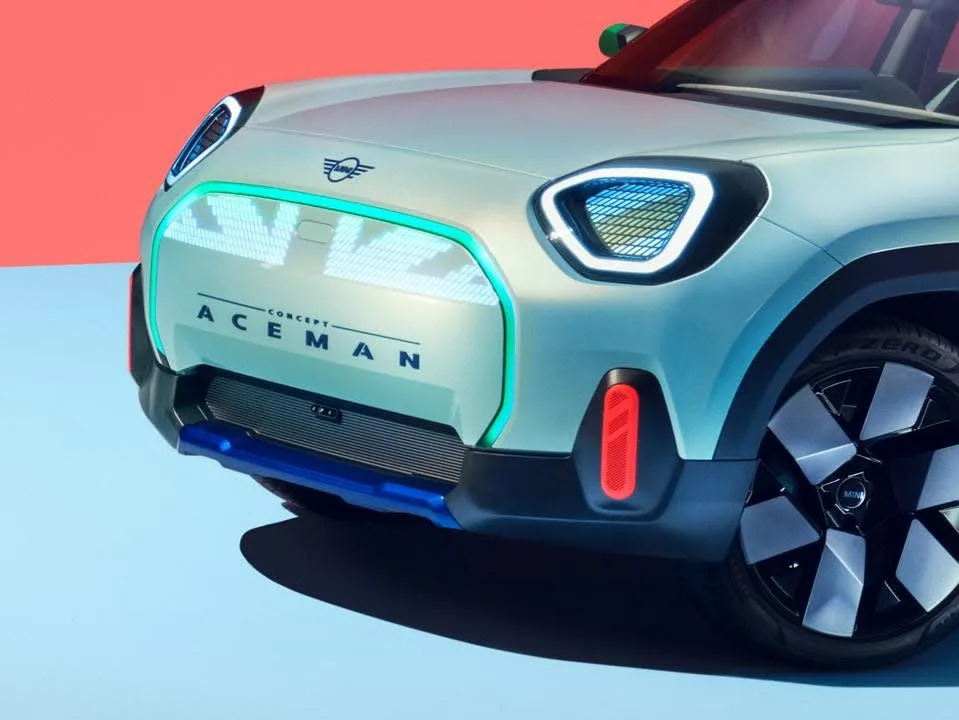Mini has revealed its new electric concept car called the Aceman. The Aceman will arrive in 2024. The vehicle is a cross between a next-gen Cooper hatchback and a Countryman, but bigger and more modern.
Mini says the Aceman represents “a new dawn” of design for the company, but it’s still a car loaded with visual cues from the trademarks of the 1959 original and BMW’s 2000 revival.
Such signs include a centrally mounted display. Mini says the minimalist dash is designed to look like a sound bar, stretching across the width of the cabin and covered in soft knit fabric for a homey feel. It also has a prominent roof rack, which has an iridescent finish that completely replaces the chrome on and off the vehicle.
The dash support structure sits in an open space between the dash and windshield, creating a void of negative space that reminds me of the similarly designed Lotus Eletre electric SUV. It’s a cramped space that appears to have been inspired by the Mini Strip, a concept produced by fashion designer Paul Smith in 2021. Of the new model, Mini design chief Oliver Heilmer said: “Inside… we focused on a pared-down look combined with high-quality materials and friendly colors… The entire design is completely geared towards giving occupants a holistic interior experience.”
Mini says it is the first automaker to create a circular OLED dashboard display and that the production version of the Aceman will use the latest Mini operating system, which for the first time will be based on the Android Open Source Project software. Beneath the display is a row of physical toggle switches, the likes of which are found on almost every Mini ever made. They switch between driving modes, adjust music volume and act as gear selectors. Recalling that not every driver wants a Tesla-style touchscreen-only cockpit, Mini says each lever is designed “for the most intuitive operation.”
As is increasingly common among automakers, and desired by drivers, the cabin is completely leather-free and features a knit fabric made from recycled polyester. The steering wheel rim and door handles are laminated with dark green velvet velour. The multifunction buttons are integrated into the spokes of the wheel, under backlit textile surfaces. Chrome was also banished from the Aceman, both inside and out, in an attempt to reduce the use of plastic on the car.
A key interior detail is the use of lighting and digital imaging to create an ambience in the cabin. Mini says how “moving image projections can transfer control system content to the entire dashboard, creating a unique digital experience that extends to the door panels.” These images can include detailed maps or digitized scattered clouds, and the color scheme and lighting moods are accompanied by “appropriate sound sequences,” says the manufacturer.
What all of this really means, or at least in terms of the concept car, is how a pair of projectors located on the leading edge of the headliner project onto the cloth dashboard. A demo given to journalists showed how this projected interface can display cartographic images or animation that makes the dashboard look like rippling water in a swimming pool. The projectors are carefully installed, so that they are not visible to the driver or passenger, but for now it is not clear if Mini intends to homologate the system for mass production, or if it is a mere prototype of tinsel.
A close inspection of the Aceman concept also reveals just how much wider the car’s body is compared to its interior. The rear seats seem to offer only slightly more space than those of the regular Mini hatchback. Mini design chief Oliver Heilmer said the production car will be as long as the concept, at 14 feet, but narrower than the 6.5 feet seen here, in a bid to deliver on its promise as an urban EV.
On the outside, sleek frameless mirrors are expected to make their way to the production version, while the relatively low, sloping roofline gives the Aceman a sporty stance accentuated by sweeping arches.

